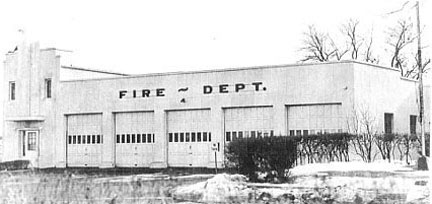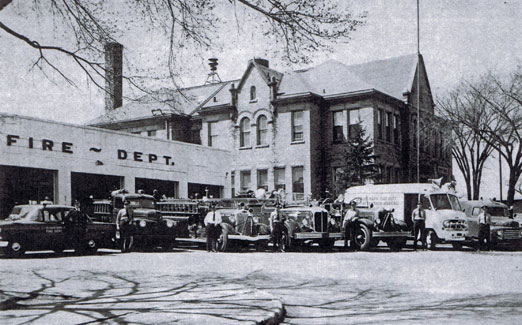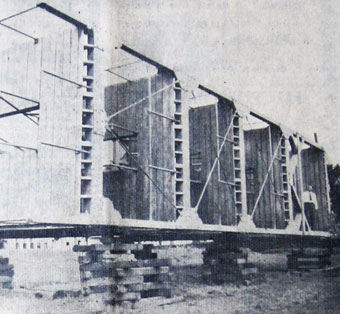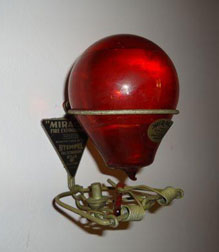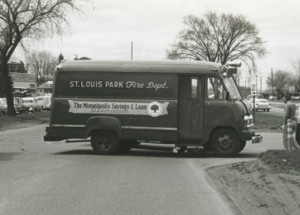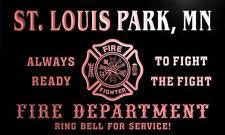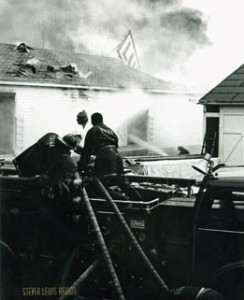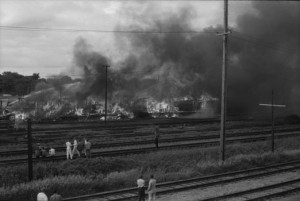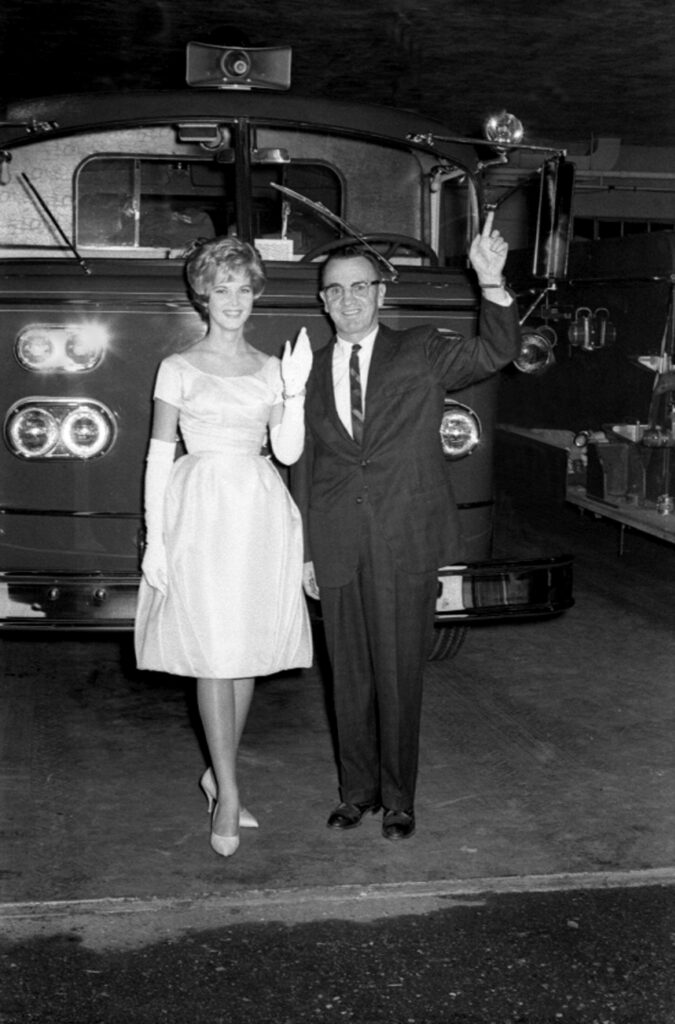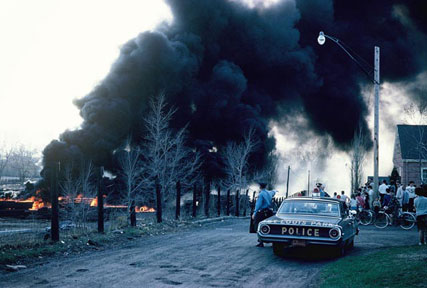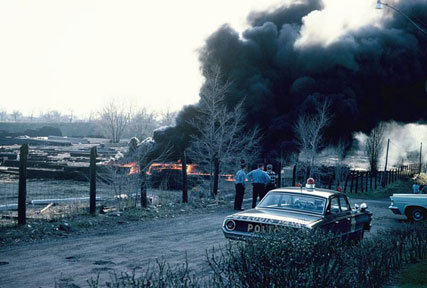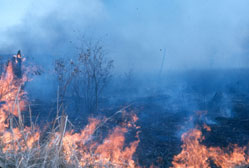Much of the information for this timeline came from a chronology on file at the Park Fire Department, written in about 1985 and unfortunately unsigned. Joe Williams also provided information in his memoir. Thank you to Shirley Huiras, former secretary at the SLP Fire Department, for sharing the Department’s scrapbooks. The Department is now in the process of digitizing those records.
Please contact us if you have any additions, corrections, or comments regarding this page.
Note: Information on Firemen’s Carnivals can be found on the Park Celebrations page.
1866
The Pratt School, located at Excelsior Blvd. and Pleasant Avenue [Wooddale] burned down and was immediately rebuilt.
1890s
The first fire barn was located on the north side of the Walker Building (6512 Walker Street). A team of freight horses was used to pull the fire wagon, which had eight 40-gallon soda acid tanks. Soda and acid were mixed together to create water pressure in the days before the water mains were installed. There were also two hose reels on had carts that were kept at Excelsior Blvd. and Wooddale. This facility moved to Monitor Drill in about 1899 and burned down in 1908.
1893
On April 7, 1893, the Village Council appointed a committee to investigate fire extinguishing chemical equipment in Minneapolis. Dan Falvey, George Thompson, and Joseph Hamilton were appointed to the committee. There’s no evidence that they bought any equipment but they did organize the first volunteer Bucket Brigade with 40 volunteers and two hand rigs (alternately reported as 16 men).
On April 16, 1893, five Walker houses burned down. The April 20 issue of the Minneapolis Tribune reported:
The fire started in the shed of the house occupied by E.L. Soderlind, and had a good headway before being discovered. John W. Farber, living upstairs, had a very narrow escape, and it was with difficulty he saved himself, wife and baby. They lost everything but the clothing they had on. Farber had a small insurance, the risk having been taken out the Friday previous. Soderlind saved some front room furniture, but everything in the back part of the house was destroyed. He had no insurance. The other buildings were occupied by Parker, Long, Blocker, Lund and others, but they saved most of their furniture. No one knows how the fire originated.
The worst fire in the history of Minneapolis occurred on August 13, 1893. It had not rained since June and conditions were right for the burning of the many lumberyards and sawmills on Nicollet and Boom Islands. The Minneapolis Tribune reported that trapped firefighters were leaping into the Mississippi River. The stats were horrific:
- 1,500 people were burned out of their homes
- 23 blocks of northeast Minneapolis were on fire
- a dozen houses erupted in the same instant
- flames shot up 300 feet in the sky
- 150 buildings were destroyed
- damages were estimated at $1 million – $20 million in 2015 dollars
- only one man died – a 70-year-old man who had a heart attack while loading his belongings to evacuate
1894
On September 1, 1894, prairie and forest fires that had spread across the state became a firestorm near Mille Lacs Lake and spread east. The towns of Hinckley and Sandstone were incinerated, and estimates of the dead start at 413 people. 248 victims of the fire are buried in a mass grave at the Lutheran Memorial Cemetery in Hinckley.
1898
On November 2, 1898, the Thompson Wagon Company burned, with a loss of $17,000 in buildings and machinery.
1899
The fire equipment was moved to the Monitor Works (Hampshire and 36th) since most of the firemen worked for Monitor. A steam heated addition was built to house the equipment.
1900
On March 18, 1900, more Walker houses burned in Oak Hill. Seven houses were destroyed, and the help of the Minneapolis fire department saved five more. The houses were only six feet apart and the fire spread rapidly. The next day the Minneapolis Tribune reported that “All the horses stood the strain well, except one of the lead horses on the truck. The roads were rough in some places. The distance from the quarter to the [Minneapolis] truck is about seven miles …” The houses were valued at about $300 each and covered by insurance. Occupants all worked in T.B. Walker’s factories.
The St. Louis Park Bucket Brigade had 20 members, including George Gibson, Charles Hamilton, Joe Williams, John Williams, Charles “Butch” Miller, Louis Brown, George Wilbur and Joe Fisher. Meetings were held in the Walker Building. The first piece of equipment purchased was a horse-drawn vehicle with two 80-gallon tanks.
On June 17, 1900, the two-story frame house occupied by G.W. Gibson, foreman of the Monitor Drill Co., burned down. Mrs. Gibson was alone in the house and neighbors woke her up at about 1 am. The rear of the building was destroyed but with the help of neighbors, most of the household goods were saved. The nine-room house was valued at $2,500. Minneapolis fire trucks were called in, and “made the run of six miles in 28 minutes, but the house was in ruins upon their arrival,” reported the Minneapolis Tribune on June 18.
Sam Sewall was hired at $65 per month to care for the new equipment and horses, which were kept at the Walker Building. He was on the payroll from November 1, 1900, to May 1, 1901.
On August 25, 1900, the Village Council voted to purchase fire apparatus from the New Jersey Spring and Rubber Company for $1,200. [Seagrave Chemical Company]. On September 15, 1900, the Village Council voted to purchase a team of horses to draw the apparatus at a cost of $300. But the Council President, C.B. Waddell, refused to sign the voucher, nixing the deal at least for a time. The chemical vehicle was kept in the Walker Building.
1901
On June 10, 1901, a committee was appointed to organize a volunteer fire department to replace the Bucket Brigade. Members of the committee were Joe S. Williams, A.T. Masters, Charles Hamilton, John E. Williams, and E.M. Trenkley. It originally had 27 members. Charles “Butch” Miller (Joseph Hamilton’s brother-in-law) was elected chief, but he resigned after six months to join the Alaska gold rush. Joe Fisher became teamster for the Department on July 1, 1901.
In October 1901 there was a fire at Hanke’s farm, and the Village paid wages for seven firemen.
1902
The SLP and Hopkins Electric Line Car Barn was destroyed by fire from lightning on October 27. (Mpls. Journal)
The Council bought 12 coats and hats for volunteers.
1903
Joe S. Williams became Chief of the volunteer fire department, serving until 1946. He volunteered while a full-time employee of Monitor until the Chief’s position became full time in 1930.
“At this time it was thought advisable to dispose of the team used in the fire department and offer a prize of $10 to the man who was first to get engine chemical to fire.”
1905
The Minnesota Sugar Plant, built in 1897, was wiped out by fire on May 2, 1905, suffering a loss of $400,000. The fire “started in the laboratory over the office in the west end of the building. D.W. Rocking, chemist, discovered the fire at 1:30 am,” reported the Minneapolis Tribune the next day. Rocking had gone to dinner at about 12:30 am and returned to find the rafters smoking. A bucket brigade was formed from the Village to no avail. The Minneapolis fire department made the arduous journey to try to help, but the fire “seemed to laugh at them and their efforts to conquer… The fire had its start and simply ate away, practically unhampered until everything had been reduced to ashes, crumbling walls, and twisted machinery.” Water applied to the fire was merely reduced to steam or thrown back by the power of the flames, which moved “upwards, outwards, and sideways.” 12 miles of copper tubing were ruined, and a locomotive was “now a warped and torn piece of junk – absolutely worthless.” Only a few buildings were saved, including a storage building holding hundreds of tons of molasses. The Tribune also noted that Villagers came from all around to see the fire and got in the way of the firemen, with no police to direct traffic. Ernest J. Lewis reported that he and the other boys at Oak Hill School jumped out the open window to see the blaze. The company had contracted for 3,300 acres of sugar beets to process, and had sold thousands of pounds of sugar ahead on contract. 200 men were put out of work for the season, which started on October 1 and ran for four months.
1906
In May 1906 a committee was appointed by the Village Council to ask the officers at Monitor Drill if the Village could use a building to house the fire engine.
1908
On April 15, 1908, a bridge owned by the Minneapolis and St. Louis Railroad caught fire, presumably from the spark of an engine, leaving it badly damaged. Minneapolis firemen were called but were hampered by a lack of water. The Milwaukee Road bridge was in danger of catching fire as well but did not. (Minneapolis Tribune, April 16, 1908)
The Iron Range experienced forest fires in September 1908, and residents of St. Louis Park contributed to the relief fund. $20 was raised by the North Side School for this purpose. (Minneapolis Tribune, September 27, 1908)
1909
A small fire at Monitor Drill destroyed the two-story frame office building on June 5, 1909. The fire was of unknown origin and did not spread to other buildings on the site. (Minneapolis Tribune, June 6, 1909)
A fire broke out at the Exchange Grain Elevator on September 16, 1909, causing damage of an estimated $50,000. The Minneapolis Tribune reported that “The side of the elevator caved in and the H. and D. tracks were inundated with grain to such an extent that traffic was stopped for several hours.”
1910
The Minneapolis Tribune of March 23, 1910, reported: “Sparks from a passing locomotive set fire to a pile of lumber near the Great Western [Belco] elevator, near St. Louis Park, last night, and for some time the big warehouse was threatened. Water was scarce and much of the lumber was consumed before the fire fighters could get down to business. Before a switch engine could be secured, one box car was destroyed, but a string of cars was pulled out in time to save it from the flames. The loss is about $3,000.”
The Minneapolis Tribune of May 2, 1910, reported that “Sparks from a passing locomotive set fire to two railroad bridges on the Minneapolis & St. Louis line near St. Louis Park early this morning. One of them was totally destroyed, while the other was still burning at the time of going to press. Two engine companies from Minneapolis were sent, and it is believed that one of the bridges can be saved from total destruction. The bridges were wooden trestles and less than a block apart.”
The Commander Larrabee Grain Elevators burned and were replaced with concrete structures.
1911
The St. Louis Park Methodist Church and a saloon in one of the hotels across the street (Brownlow) caught fire and the volunteer firemen arrived and found it engulfed in flames. The story goes that the firemen knew they couldn’t save the church, so they went across the street to try and save the saloon. The minister saw the firemen go over to save the saloon and he cried out “They’re letting God’s house burn and saving that Devil Establishment over there!” But apparently the church was rebuilt, only to be severely damaged in the tornado of 1925.
1912
Prairie fires were reported by the Minneapolis Tribune on April 10, 1912, including one that burned two stacks of hay worth about $13 a ton.
The Great Northern Hotel burned to the ground on June 24, 1912. Despite assistance from two engine companies from the Minneapolis Fire Department that raced four miles, the building, owned by T.B. Walker, was a total loss, valued at $10,000 (covered by insurance). Somehow, the reaction to the fire by the hotel’s guests was the defenestration of valuables. A contemporary news account is worth the reading:
Mrs. L.C. Sprague, proprietress of the hotel, asleep when the fire was discovered, refused to get up, believing it was not serious. Later she was carried out in her night attire by Fire Chief Joseph Williams… Many persons narrowly escaped injury when a big chimney fell. The hotel had fifty rooms and was full of guests. Thirty-five [who] were at breakfast… ran upstairs and roused the sleeping guests…. These articles were tossed from second and third story windows:
- One piano, which was shattered beyond repair when it struck.
- One big refrigerator, which suffered a similar fate.
- One chair, which struck William Chase, 14 years old, and broke his arm.
- One water pitcher, which struck Howard Bradford, 17 years old, on the head, inflicting a severe scalp wound and knocking him down.
In 1963 Pete Williams recalled what his father, Fire Chief Joe Williams, told him about the fire: “There was so much confusion that firemen threw mirrors out the windows and carried mattresses that could have been thrown out the windows down the stairs.”
1913
The Minneapolis Tribune reported a fire on December 22, 1913, at the old Presto-O-Lite Company, with a loss estimated at $5,000. “The flames spread rapidly through the main building and out-buildings. A bucket brigade aided by an old band fire engine of the Monitor Drill company were ineffective. The building was occupied temporarily by the company following the destruction of the Midway plant a year ago. It was vacated late in November. The explosion of a drum of acetone, used to absorb gas from small tanks, scattered the amateur fire fighters when the blaze was at its height.”
1915
On August 19, 1915, the St. Louis Park Herald reported that the Commercial Club held a Mass meeting to organize a Volunteer Fire Department. 25 volunteered, and it was expected that at least 40 would eventually volunteer. A committee was appointed to write a constitution and by-laws. The state fire inspector and state commissioner were also present. The Department was officially organized on September 2, 1915, at a meeting at the High School. This date is considered the official beginning of the Fire Department in St. Louis Park.
Officers were:
- Chief: Joseph S. Williams
- Assistant Chief: Walter Moore
- Secretary-Treasurer: Roy R. Johnson
- Trustees: Charles Hamilton, Dr. G.M. Wade, Elmer Whipps
Frank Heyda moved to purchase a 40 gallon chemical tank for a truck and a light automobile, not to exceed $1,600, to be housed near either Lincoln School or the High School.
In October 1915 a two-wheeled chemical vehicle was purchased from W.S. Nott for $275.
1916
The 14-member Fire Department was reorganized and divided into two sections; south and Lake Street. Joe Williams was elected Chief, and Axel Carlstrom was Assistant Chief.
The Ainsworth Brothers and the St. Louis Park Volunteer Fire Department hauled chemicals to fight the Johnson fire in April 1916 and requested reimbursement of expenses from the Village Council.
Although there are references to the Volunteer Fire Department above, the October 6, 1916, Park High Echo reports that it was organized “during the past year.” A dance was given on September 22, 1916, to raise funds for more equipment. Here’s more:
The fire department has at this time one large chemical engine, two small two-wheeled chemicals and one hook and ladder wagon. At present they have no horses or motor power to pull the engines, but men living in the vicinity of the fire stations haul the apparatus by hand or by autos which are offered for this work. The equipment they now have is sufficient to put out small fires but there is not enough pressure to get large fires under control.
Pros and cons were then listed as to using horses (which have to be fed between fires) and engines. The Village Council discussed installing a Tri State telephone in the Fire Chief’s residence or the Monitor Engine Room.
1917
Four men were injured in a January 28, 1917, fire in Fern Hill. Neighbor Frank Bronsdon discovered the fire and thought he heard cries for help, reported the Minneapolis Tribune. As Bronsdon opened the back door, someone opened the front door and “a draught caused the flames to envelop Mr. Bronsdon as though there had been an explosion.” He was taken to St. Barnabus Hospital. Other neighbors carried out all the furniture from downstairs and attempted to reach the ground floor, but were driven back. Efforts to extinguish the flames with snow proved useless and caused minor burns on three who tried. The occupants of the house were away. Minneapolis firemen were sent to the scene “but were helpless through lack of water.” They were able to save the neighboring lot.
A huge fire hit the Walker Building early on February 3, 1917, reported the Minneapolis Tribune. It started at the meat market of A.M. Shields, located in the Walker Block, then the center of Park’s business section. The blaze was discovered by Dan Saara, who ran a rooming house on the second floor of the Walker Building that housed 100 men who worked at the Monitor Drill. The report says “Because of a high east wind, hope of saving the building was abandoned early, and all efforts were turned toward preventing a spread of the flames.” An engine company was called from Minneapolis, but they got stuck in the snow three miles away. The firemen walked the rest of the way and gave what assistance they could. Other businesses in the Walker Building were Doc Brown’s Barber Shop (listed as Brown and White), the Athens Restaurant, and M. Dworsky & Son, general merchandise. The small moving picture house operated by Jake Werner and Eric Liljenfors did not resume after the fire.
A Wilcox truck, made in North Minneapolis, was purchased and mostly used for grass fires. It cost $3,000 and had four 40 gallon tanks – soda and acid were dumped together to get pressure. It was the first motor-driven piece of fire fighting equipment in the Park.
1918
The Village purchased a former saloon from a Mr. Carlson of the Minneapolis Brewing Company for $2,000. The building, at 36th Street between Brunswick and Dakota, became the new fire barn. It was used until 1938. Firemen were issued fisherman-style raincoats and hats, which were not warm enough for the winters. Paid members were given $3 per fire, payable at the end of the year. oe Williams blew a steam whistle at the Monitor Drill to call volunteers to the fire; the number of blasts told them which section of town the fire was in. The whistle carried 10-15 miles. The whistle is now on display at Fire Station #1 on Wooddale Ave.
Marie Hartmann remembered the whistles this way:
- Between Milwaukee Road/M&SL tracks and Minnetonka Blvd.
- Between the tracks south to Excelsior Blvd.
- North of Great Northern tracks.
- Fern Hill: Zarthan to Louisiana, Great Northern tracks to M&SL
- Brookside: Between Excelsior Blvd. and 44th Street
- Oak Hill: Louisiana to Hopkins limits
Lars Johnson joined the force in November 1918. Lars was born in Mess, Norway on September 15, 1888, and came to the U.S. in 1907, at age 19. He worked at the state hospital in St. Peter for three years, moved to Minneapolis in 1910, and then to the Park. He was the second man to become a paid member of the Fire Department, alternately reported as 1930 or 1932. Since Fire Chief Joe Williams was also the Water Superintendent, one of Lars’s duties was to make out the water bills. He spent 44 years as a Park firefighter, and in an article in the Dispatch dated October 29, 1959, he recalled the old days and pushing the old hand cart.
A horrific wildfire hit northern Minnesota on October 12, 1918. Winds up to 60 mph combined many smaller fires into a miles-wide inferno that literally incinerated the towns in its path, including Arnold, Automba, Brookston, Cloquet, Kaleval, Kettle River, Lawler, Lester Park, Moose Lake, and Woodland. Many others were damaged. 453 people and tens of thousands of animals died and many more suffered burns. Duluth only escaped certain destruction when the wind suddenly reversed direction – with nothing left to burn, the fire died. Local car dealer Win Stephens headed up the Home Guard Motor Corps, made up of private citizens who owned automobiles. The Motor Corps arrived from Minneapolis in 12 hours. They transported refugees, found bodies, dug graves, transported food and clothes.
The Spanish Flu hit this area of Minnesota one week later, testing the medical resources of the State severely.
1920
1921
A terrible fire took place at the Belco Elevator in Manhattan Park in 1921.
On March 3, 1921, Village Council President James Guy had to leave the meeting to fight a fire near the Prest-o-lite plant.
40,000 gallons of oil exploded at the Creosote Plant at midnight on July 3, 1921, reported the Minneapolis Tribune. Damage was estimated at $25,000. “The oil let loose with a low, muffled rumble. Neighbors several blocks away were disturbed and on reaching their windows saw flames shooting high in the air. The oil did not run from the vats, but burned in three furnaces. A new process being used to separate the oil for creosoting work was blamed as the probable cause. The blast tore the roof from the building… A fourth vat adjoining the three that exploded was saved.” A Minneapolis engine company was called to assist in fighting the fire.
A fire at the McCollom Dairy Farm in Golden Valley destroyed buildings at a loss of $10,000. The Minneapolis Tribune reported that “Automobile traffic on the road to the farm was so great that the St. Louis Park fire department was unable to get through, and before firemen reached the farm the fire had spread from the barn, silo and outbuildings to the residence…. Fifty head of cattle usually house in the barn were in the pasture.”
A fire at the Pockrandt Lumber Yard lit the sky for miles, reported the Minneapolis Morning Tribune on October 27, 1921. The fire swept over 25 city lots and caused $75,000 in damage. “Half a million feet of lumber and 720 tons of coal were destroyed. The adjoining tracks of the Minneapolis & St. Louis railroad were badly warped. The loss is only partly covered by insurance. Large crowds of Minneapolis residents who gathered in automobiles were thrilled when a Minneapolis & St. Louis switch engine crew backed into the track nearest the yards and drew out three box cars filled with lumber, one of which was ablaze.” Joe Williams said his volunteer firefighters were hampered by the lack of water pressure. Minneapolis sent three companies to help guard against the spread of the fire.
1922
The Minneapolis Tribune reported on a fire at the Creosote Plant on December 15, 1922: “Flames accompanied by dense clouds of black smoke shot hundred of feet into the air… destroying one-half the main condensory plant… causing a loss of $100,000. Four Minneapolis fire companies battled desperately for several hours before the oil-fed blaze was subdued. Five huge tanks containing 1,000,000 gallons of creosoting oil were menaced by the fire.” The five tanks and the main building of the company were saved when a tunnel between the tanks was blocked. “Work was handicapped by the intense cold and by dense clouds of smoke which surrounded the plant. The main plant was coated with ice.” The fire was caused by spontaneous combustion, endangering 50 workers who escaped without injury. The rest of the plant was saved by closing fire walls. Many of the 150 employees would be out of work until repairs were made.
1924
The following article, from an unnamed paper, is dated April 1924. It shows that fighting three fires at once, even with the help of Minneapolis, was quite a challenge. In its entirety:
ST. LOUIS PARK FIRE CUTS PHONE LINES
Bucket Brigade Saves House – Flying Embers Peril Lumber Yard – Two Injured
While St. Louis Park firemen were fighting a grass fire nearly a mile from town, two fires that broke out almost simultaneously in town destroyed an ice house and a barn, and killed tow horses late Saturday. Two men were injured while fighting the fire. Damage was estimated at $8,000.
Telephone communications were cut off in part of St. Louis Park when a cable near the ice house was destroyed by the heat from the fire. Service crews were working on the cable late Saturday night.
A bucket brigade that passed water to fire fighters on the roof of the Lertch home prevented flames from spreading from the barn to the house. Burning embers were carried across the road to the lumber years of the Pockrandt Lumber Company, also, and a bucket brigade kept guard there until the chemical company arrived from Minneapolis.
John Applequist, owner of the icehouse, was injured when an ax slipped and cut a gas in his left hand. He was chopping at a wall when injured. Willard Williams, son of a member of the St. Louis Park fire department, was injured when his left hand was cut in a similar way.
In the icehouse were 1,200 pounds of ice, Mr. Applequist said. The flames melted the ice, water flowing down the street. A small well about 60 feet from the ice house furnished the only supply of water, and it was inadequate for the Minneapolis and St. Louis Park firemen fighting the two fires.
The ice house for Applequist’s Public Ice Co. was located at about where Wooddale now meets Highway 7.
1925
The Martin Manufacturing Company factory, built before 1902, burned to the ground on October 15, 1925. The company manufactured grain grinders.
1926
North (Side) School, at 6800 S. Cedar Lake Road, burned on April 2, 1926; legend has it that a janitor fell asleep and his newspaper caught fire.
1928
The Hennepin County Enterprise reported three separate fires in Brookside in its November 29, 1928 issue. The damage was slight in all three cases.
- A grass fire at Fendly (no such street) and Pomona (now Yosemite) which had been started by some boys.
- A fire on the roof of Dr. William Martin, 4128 Yosemite Ave.
- The Russell Ronning home on Webster Ave., which started from an overheated stove.
1930
The advent of the Village’s water system made it possible for the Park to buy a new red and yellow pumper truck named “Molly” from American LaFrance for $13,500. The truck was made in Elmira, New York in 1928. The truck had six cylinders, triple ignition, an 855 cubic engine, and could pump 1,000 gallons of water per minute. Designated Number 212, it was the first quad pumper in the area. It was shipped to St. Louis Park by boxcar. Molly has been restored and is on display at Fire Station Number 1 on Wooddale Ave..
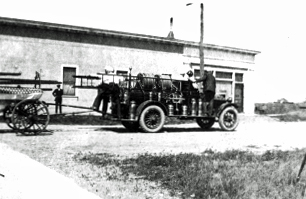
On February 14, 1930, the vacant Moline Plow Company burned down under what some say were suspicious circumstances. The fire was started by a watchman’s stove and did $290,000 damage, all covered by insurance.
A paid fire department was established in 1930, with Joe S. Williams appointed Chief and Axel Carlstrom Assistant Chief. At first only Joe Williams was paid; Lars Johnson, a volunteer since 1918, was added to the rolls in 1932, Kurt Scheibe in 1937 or ’38, and Pete Williams and Harold Hoffstrand in about 1941. Williams was also Superintendent of the water system, which had just been established with the first 28 miles of water mains.
From the October 23, 1930, issue of the Hennepin County Review: “Fire, caused by an overheated stove, nearly destroyed what was once the ‘pest house‘ for the city of Minneapolis on Saturday night. The house was occupied by J.O. Johnson and family. The interior was practically destroyed and the damage estimated at $4000. Both the village and city fire departments answered the call.”
1930s
Firefighters put out hundreds of grass fires, especially in the north side, which was just peat fields and swamps. They once put out 49 grass fires in one day.
Firefighters were heroes in town, and there was a waiting list to join the Volunteers, as the roster was kept to 25 at a time. The Volunteers elected their own Fire Chief, but it was always Joe Williams.
1933
Park’s first phone directory cites Ed Werner and Lars Johnson as Chief Williams’ assistants, and says that the department was staffed with 40 volunteers.
1933 was also the year of a small fire at the Post Office, then located at Dakota and Walker.
1935
In late January 1935 a fire at 3725 Oregon Ave. destroyed the home of Mrs. Wayne Crosby, who suffered burns on her face and body. The fire started when her husband found a frozen can of motor oil in his car and put it on the kitchen stove to defrost. He left to do some errands and the can burst into flames, instantly engulfing the house. Mrs. Crosby picked up her 18-month-old son Norman and ran for the door but was unable to open it. The Hennepin County Review reported:
Protecting the boy with her own clothing, she smashed one of the windows and tossed him out into the snow. Her own clothing aflame, she climbed through the window, where neighbors found her a few minutes later, unconscious. Except for a few cuts on his hand, Norman was none the worse for his experience.
Another fire that same week caused damage to the home of Sig T. Olson, residing at 4304 Coolidge Ave. Olson and his 16-year-old son Roy were working in their garage and did not discover the fire in the house until it was well underway. Olson ran into the house to gather some belongings in a bushel basket, but his clothes caught fire and he was severely burned on his face and hands. Mrs. Olson and two sisters were at the movies at the time and escaped injury. (Hennepin County Review, January 31, 1935)
The Department was put under Civil Service and out of politics (1938).
Mrs. Nina Rebmann died of her injuries from a fire in her home that started when paraffin she was melting to seal fruit jars ignited. Mrs. Rebmann lived at 2930 Natchez.
1936
George Gibson joined the Volunteer rolls in December, and lived at the station until he got married in 1938. He became a paid firefighter in 1942.
The summer of 1936 was the time of the great North Side peat swamp fire. This first hand account is by John Yngve.
1938
A new Fire Department building was erected at 5921 W. 37th, next to the Lincoln School/City Hall. The building cost $6,433 and provided space for five engines and sleeping quarters for five men. There was also a two-story section, used to dry hoses. The siren atop the Fire Barn was eventually given to the Fifty Lakes Fire Department.
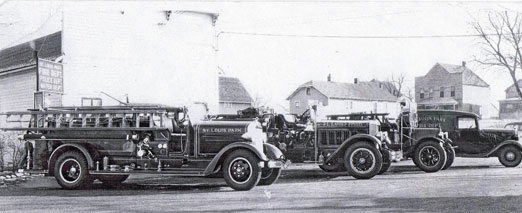
A 500 gallon LaFrance pumper was purchased in 1938.
A roster from September 1, 1938, lists each current volunteer fireman and his tenure. An excerpt is included at the end of this chronology.
1939
“Fumes From Mattress Fire Cause Death” was an undated headline about the death of George McNally, 34, who had the habit of smoking in bed. The article said that McNally, his father, George, Sr., and his sister Myrtle lived at 2720 First Ave. So. The 1933 directory puts George Jr. and Sr. at 7623 North Street (formerly 1st St. N) and Myrtle at 7428 South Street (formerly 2nd Street), in Oak Hill. The use of the old names implies that this was before 1933, and yet both Georges are in the 1933 directory. Ancestry shows George, Jr. died on March 4, 1939.
A fire in April 1939 at the Creosote Plant brought between 2,000 and 3,000 onlookers to Highway 7. The blaze was started by boys burning grass along a 20-acre swamp where the plant drained its byproducts. The fire swept over the 20 acres of grassland and then ignited a 20-year accumulation of oils and greases in the marshy bottoms. Firemen were powerless to stop it and concentrated on preventing it from spreading. The swamp was located between Highway 7, Lake Street, Quebec, and Louisiana.
1940
St. Louis Park played a small role in the formation of the Golden Valley Fire Department, according to Golden Valley’s 1986 history book. In 1940 there was a roof fire at the Lynde home on the NW corner of Glenwood and Xerxes Avenues, now part of Theodore Wirth Park. The Minneapolis Fire Department answered the owner’s call, but the Minneapolis Fire Chief ordered the ladder removed before the fire was put out since the house was not in Minneapolis. St. Louis Park’s Fire Department refused to help as well. Finally, Robbinsdale agreed to help if $35 was deposited at the Robbinsdale City Hall. In the meantime, neighbors had formed a bucket brigade and doused the blaze. The incident demonstrated to the Village of Golden Valley the importance of forming its own fire department. Even then, the only firefighting equipment consisted of fire extinguishers that they buried in the dirt floor in the basement of the village hall to prevent the water in the extinguishers from freezing. A fire call necessitated the digging out of the extinguishers.
1941
Zimmerman A. Pattison of 3100 Salem Ave. was convicted of third degree arson when he tried to burn his house down with turpentine. Firemen were suspicious when they discovered that the fire had started in two different places. Pattison had done it for the insurance money.
1946
Joe S. Williams retired as Fire Chief, and was succeeded by his son Charles M. “Pete” Williams. Other sons Howard and Willard also served for many years as volunteer firemen. See the Williams Family.
1947
In June 1947 the Fire Department purchased six Janesville Raincoats for $14.48 each from the Minnesota Fire Equipment Co.
1948
Nine men joined the International Association of Fire Fighters on August 17, 1948.
Seventh grader Bob Olson, working as a paperboy at the Calhoun Beach Hotel, saved 250 lb. Harold Kister from a fire there in 1948. On January 21, 1950, Olson received $50 raised by residents of the hotel and received an award from the National Association of Bona Fide Heroes.
1949
A fire at St. George’s Episcopal Church on February 7, 1949, demolished the parish house and gutted the Quonset hut. It reopened on May 13.
The house of Melvin W. Fisher, 3781 Kipling, exploded on November 18, 1949. Fisher tried to collect damages from the Village but was denied.
A Reciprocal Fire Service Agreement with Richfield, Edina, Hopkins, and Golden Valley was approved on August 1, 1949.
A water tank caught fire on February 7, 1949, causing $100 in damages.
1950
There was a fire at the Brookside Market (6007 Excelsior Blvd.), which prompted the owner to sell it to Nate Goldstone. The two buildings were combined to house an expanded Brookside Drug.
A fire at National Lead, 36th and Hampshire, caused $30,000 in damage. The fire was slow to be put out because it burned up the phone line, and the workman’s car used to make the alarm stalled.
On January 14, 1950, a Christmas tree bonfire was held at the athletic field. This was the second annual for this event.
1951
There were 11 men on the fire department payroll plus a volunteer force, operating three trucks. The State gave the Department a rescue truck.
On June 13, 1951, Lambin Motors, an auto body shop at 4825 Excelsior Blvd., sustained $7,000 – $10,000 damage in a two-alarm fire. The fire was first spotted by a German exchange student on a motorcycle who was looking for a house five blocks away. The fire started in a wastebasket, perhaps by a cigarette. Fifteen cars were damaged, including five new 1951 Mercurys. Paint was damaged, windshield broken, and a convertible top destroyed, but “strangely, the upholstery in all the cars was undamaged.” Naugahyde? The building, built in 1926, was the old St. Louis Park Garage. In 1951 it was owned by Fred L. Schroeder of Deephaven, who may have owned it as far back as 1930. In the aftermath of the fire, E.J. Lambin wrote a letter to the Council commending the fire department and sent $50 for the Firemen’s Relief Fund.
January 6, 1951, saw the third annual Christmas Tree Burning, held at Minikahda Vista Park, 39th and Inglewood. It was reported that 3,000 trees were burned.
On March 19, 1951, a fire caused $250,000 damage to businesses at Minnetonka Blvd. and Dakota: Penney’s Supermarket (6312 Minnetonka), Brink’s Variety Store (6316), Atkinson Drug Store (6320), and the offices of dentist R.N. Nelson. It started when a 16-year-old Brink’s employee burned waste paper in an incinerator. The block had just been completed on July 1, 1950. Firefighters from Golden Valley, Hopkins, and Richfield responded to the call – the largest fire call met by the SW Fire League – a group of suburban firefighters.
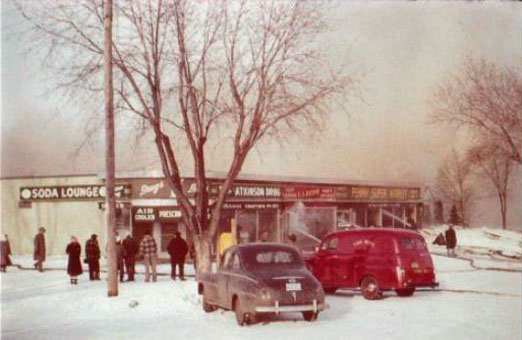
In May 1951 Mr. Edwin A. Carlson attempted to set fire to the Lakeland Door Company. His motive was not reported.
1952
Park’s biggest fire of the year caused $20,000 damage to a half-dozen businesses at the corner of Excelsior and Joppa.
There was an explosion at the Metalloy Plant, Cedar Lake Road and Dakota, on April 22, 1952.
 Letterhead from 1952
Letterhead from 1952
1953
A grass fire that started on November 9, 1953, turned into a peat fire that burned 40 acres of the north side well into December. The peat was estimated to be 30 ft. deep, and the area had to be flooded to put out the fire. The area was bounded by Westwood Hills Golf Course to the west, Franklin Ave. on the north, Louisiana to the east, and Cedar Lake Road to the south.
1954
On January 18, 1954, invalid Edward Fisher died in a fire at his home at 2936 Raleigh. The fire was caused by a cigarette.
On October 12, 1954, kids playing with matches set fire to the warming house at Dakota and the MNS railroad tracks.
The Park Fire Department assisted Golden Valley with a fire at The White House, 4900 Olson Highway, on April 4, 1954. GV thanked Park for its assistance with this “tragic” fire.
Fireman Willard Murphy injured his arm during a blast at Knollwood Plaza in November.
During 1954, firemen answered a record 537 calls. Or 548. Losses were held to $40,405. Eight inactive members of the Volunteer Fire Department were told to “settle up before the Charter takes effect,” per City Attorney Edmund Montgomery, at risk of losing their pensions. The League of Women Voters found that firemen received no special training, although they participated in many drills. At that time there were 18 paid firemen, 21 volunteers, and 4 engines.
1955
The ranks of the Volunteer Fire Department were greatly reduced in February 1955 with the advent of the new civil service paid Fire Department that resulted from the new City Charter. It also appears that many men were forced to quit because of a mandatory retirement age of 60. The City Fire Department was formally established on May 19, 1955. There were 16 paid firemen on the job for the new City.
There was a fire at the Minneapolis Golf Club during the night of March 25-26, 1955, causing $100,000 in damage. This was deemed St. Louis Park’s worst fire since 1951.
For $1 the St. Louis Park Fire Department purchased a fire training tower from the City of Minneapolis. The structure was five stories high with floors, stairways, windows, and walls. It was to be erected next to the police station, but lay on it side for awhile, and of course a kid was playing on it and fell off and got hurt. Photo below from the June 9, 1955 Dispatch.
A short in the control box caused a fire at the pumping station at 2946 Idaho on June 22, 1955.
The old Lake Street Community Center suffered fire damage. Insurance proceeds and $2,750 from developer Ecklund & Swedlund was used to dig a 75’ by 25’ basement.
In the early 1950s the Village acquired the Sterling Stageberg property at 4421 W. 28th Street. For a time they used it as the Village’s Civil Defense HQ. A big civil defense demonstration was conducted on February 24, 1955, when residents were invited to watch 50 volunteers battle fire and teargas to rescue victims. The drill was conducted by the CD rescue squad along with fire and police reserves. An old stable at the Stageberg property was ignited and volunteer victims were placed in upper stories of the HQ building, lowered through windows on stretchers. Tear gas was used to familiarize the men with their gas masks. The house on the Stageberg property was wrecked in October 1955. The site is now part of Fern Hill Park.
For the first time, the Fire Chief got an official car after using his personal car for years. Picture in the August 25, 1955, issue of the Dispatch.
Some older homes in St. Louis Park had these ancient fire extinguishers. They were filled with carbontetrachloride and were spring loaded, with a heat sink that would melt at certain temperature, releasing a spring mounted “breaker” like a mouse trap going off. They turned out to be very dangerous.
Fire Prevention Week was held on October 9-15, 1955. This was a national event to call the public’s attention to the need for special care in the approaching heating season. In conjunction with the activities, St. Louis Park had its first Flame Queen contest, sponsored by the Fire Department. Girls with red hair, grades 9-12, were eligible to run for Flame Queen. The winner would reign over special fire prevention activities during the week and have a place of honor in the Fire Prevention Week parades in St. Louis Park, Minneapolis, and Hopkins. The queen was chosen by a committee of firemen, including Assistant Chief George Gibson and Dick Senander. The winner was 17-year-old senior Arlene Mattson. In 1956 Arlene won the Betty Crocker Homemaker of Tomorrow Contest. Her Flame Princesses were Marcy Kay Bach and Diana Glickman.
The enormous Biltmore motel in Edina caught fire in November 1955, and St. Louis Park helped fight the fire with 19 firemen and four pieces of equipment. The blaze lasted for six hours and required the work of up to 100 firemen and 20-25 pieces of equipment from seven fire departments. Park fireman Robert Bramwell suffered a gash on his hand that required five stitches. 100 motel guests were safely evacuated.
The Market Basket grocery story at 6006 Excelsior Blvd. caught fire in November 1955, and dense smoke and crowds of onlookers made fighting the fire difficult for St. louis Park, Edina, and Hopkins firefighters. The fire started in the basement of the stucco and wooden building and burned through the main floor. $35,000 in food was destroyed, according to owner Tom Wheaton.
A serious fire damaged the Minnesota Tree Service building at 4601 Excelsior Blvd. on December 12, 1955. The fire, which started from an overheated stove and spread into the attic, was contained by nine firemen in two trucks, who prevented it from spreading to a nearby lot containing hundreds of Christmas trees and wreaths. Dispatch December 15, 1955. Despite the fact that firemen had to chop a hole in the roof, business owner Byron Bell declared that his firm was open for business.
Fire destroyed five milk trucks at Baldwin Dairy at 4910 Excelsior Blvd. on December 20, 1955. The blaze took 15 firemen to extinguish, in sub-zero temperatures. The fire started at 7am when a gas heater used to heat the trucks exploded in the firm’s garage. It spread into a false ceiling above the bottling room. The former Engell Dairy was still owned by Al and Reuben Engell. Edina firemen manned the St. Louis Park fire station during the emergency.
What started as a small event in the neighborhood of the fire station eventually became almost city-wide: A firefighter dressed up as Santa, distributing candy to children from a firetruck cruising through town. Many people remember this exciting event, waiting for Santa to come down their street!

1956
Fire Prevention Week was held on October 5-13. Firemen visited each of the ten elementary schools five times, showing films and teaching fifth graders about fire prevention. Each student who passed a test, memorized the number of the fire department, and made a home inspection earned a silver Inspector badge. Each student also wrote an essay; the best boy and girl in the classroom were awarded Captain’s badges, the best boy and girl in the school received bronze medals, and the best boy and girl in the City received Gold Chief’s badges and rode on the fire engine in a twilight parade.
The 1956 parade was on October 13, leaving the Wooddale fire station:
- east to Highway 100
- north to Highway 7
- east to France Ave.
- west on Lake Street to Texas Ave.
- south to Highway 7
- east to Highway 100
- south to Excelsior Blvd.
- east to France Ave.
- south into Edina
Part of 1956’s Fire Prevention Week was the selection of the Flame Girl, one of whose requirements was that she have red hair. Candidates as of October 4 were Diana Glickman, Mary Jo Garland, and Jeanne York. (Dispatch, October 4, 1956)
here was a serious fire that destroyed the Browndale Park shelter, costing the city $93.45.
Fire broke out at Lederle Labs, 7630 Excelsior Blvd. in July 1956.
The clubhouse of the Westwood Hills Golf Course suffered a devastating fire on September 30, 1956. Firemen were first called to the scene around 9pm to put out a small fire in a wastebasket, which was quickly extinguished. After firemen had been back at the station for about a half hour a second call came in; Chief Pete Williams said the two calls were not related. When they arrived the second time, flames were coming through the roof from a fire that started in the kitchen. Every Park firefighter used every piece of equipment to fight the fire, while firefighters from Hopkins manned the station in case of other fires. Four pumper trucks brought water, but when that was used up, the nearest hydrant was almost a mile away. Manager John McNulty estimated that the damage could go up to $100,000; the building had been built by his grandfather in 1928. The land that was once the golf course was later developed into houses and the Westwood Nature Center. (Dispatch, October 4, 1956)
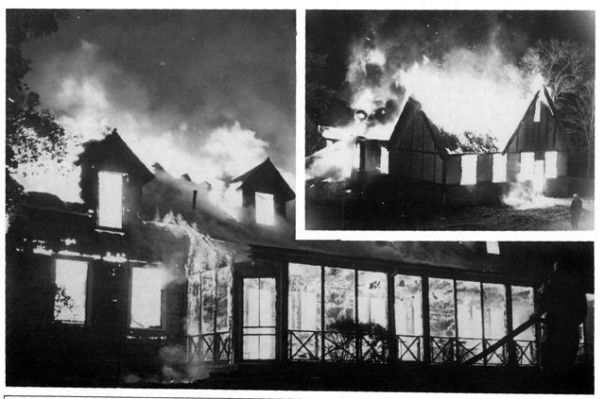
1957
The old Lufkin house was built in 1892 on a 12 acre site on 37th Street between Highway 100 and Wooddale Ave. (approximately where Micro Center is now). The house was built by Oscar Bakke and later belonged to William Lufkin, the custodian of nearby Lincoln School. The City purchased the property in 1945 and rented it to Cliff D. Odean from about 1945 to 1954. It was vacated in 1955, and the city considered using it as a Civil Defense building. It was burned to the ground by the fire department for training purposes on April 14, 1957. The 18-man paid Fire Department was assisted by the 19-man Volunteer Fire Department.
1958
A reciprocal fire agreement was approved on February 3, 1958.
A fire that started in the attic of 7004 W. 26th Street threatened to engulf the entire house owned by Leon M. Berg on June 8, 1958.
Noted in a photo of an accident at Highway 7 and Wooddale is the fire vehicle below. Curious that it has an ad on it! This is probably an early rescue vehicle and was likely donated by the bank.
The Hamilton Building/Masonic Lodge, 6505-07 Walker Street, was destroyed by fire in a 12-hour blaze on December 25-26. Click on the link to read an extended account of the fire.
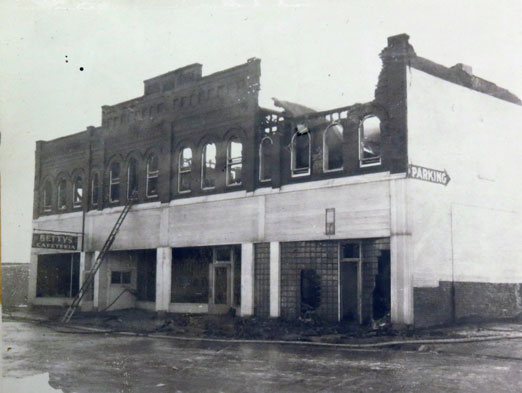
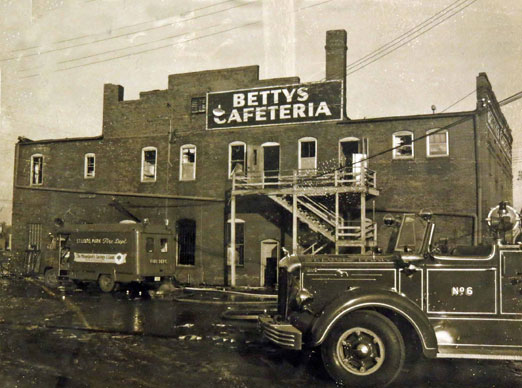
1959
A remarkable 35 grass fires, two house fires, one car fire, four first aid calls, and one school alarm occupied the fire crew in one day on March 26.
1960
On January 11, 1960, a furnace explosion at the Flame Heat Treating Plant at 3525 Hampshire blew an iron door that was 1 ft. thick across the room.
Park Drug caught fire on March 24, 1960, causing $38,000 in damages. To add insult to injury, robbers entered through a temporary door used during reconstruction.
On May 17 Dennis Haakenson, 24, was burned on his left arm and hand and both legs when the garage at 3050 Utah exploded. He and a friend were using gasoline to clean/repair a motor.
On November 2, 1960, Firemen Art Buelow and Bob Bolmgren helped deliver a baby.
1962
On January 20, 1962 (1960?) Mrs. Margaret DeReimer, 3310 Glenhurst Ave., died in a fire caused by a cigarette. It was the first fire casualty since 1954.
The Department bought a 1250 gallons per minute pumper from American LaFrance, Eau Claire, Wisconsin, for $23,990. It was made in Elmira, New York and shipped by freight train.
In August 1962 a fire at Lumber Stores, Inc. on Highway 7 required five trucks from the Park, two from Edina, and two from Hopkins to extinguish. It resulted in $100,000 in damage. The yard was at the site of the current Nordic Ware tower. The Dispatch reported that the 240 x 32 ft. warehouse was a total loss, and that Fire Chief Pete Williams had requested the State Fire Marshall to help in investigating possible arson. The owner of the lumber yard was George J. Fullerton.
Photos below courtesy of Steve Brown.
1963
The Minneapolis and St. Louis Depot was struck by fire on February 11, 1963. Although it was across the street from the fire barn, lines had to be run under the tracks, slowing the dousing process. Damage was heavy, and the depot had to be demolished. An electric heater was said to be the culprit.
Jane Veker was selected to be both Miss St. Louis Park and Miss Firefighter in 1963. Apparently “Miss Flame,” with the requirement that contestants have red hair, had been discontinued. Photos below by Steve Brown; first picture is with Fire Chief Pete Williams.
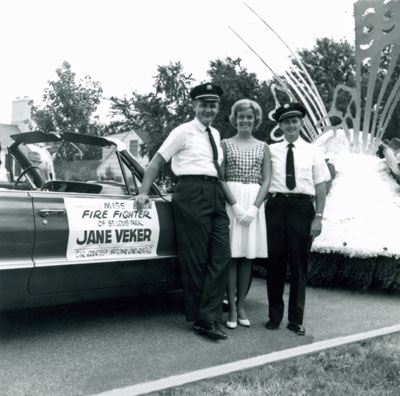
In September 1963, 400 people attended the dedication of the North Side Station – Station No. 2 at 2262 Louisiana Ave. Cost: $96,102. It was built by the Magney-Iverson Construction Co. More equipment was purchased, but no new men were hired to cover the two stations. During the open house, fire fighters were called to put out a fire on a garbage truck a few blocks away. Fire Chief Pete Williams said that the new station would cut response time to the North Side from 6 to 3 minutes. A Dispatch article reported that VFW Post 5632 conducted flag raising ceremonies, and William Williams donated two spruce trees in honor of his brother J.S. Williams, Park Fire Chief from 1891 to 1945.
1964
In May Stew Thornley captured these pictures of a smoky fire at the Creosote Plant that drew an audience of neighborhood kids.
On October 1, 1964, Kurt “Cord” Scheibe, a Park firefighter since 1922, died of a heart attack at age 61 while fighting a small fire in the “bag room” at the National Lead Company. Scheibe was born in 1903 in Germany and had come to the Park with his parents in 1907. He lived at 5825 Goodrich Avenue.
In December 1964 fire caused at $250,000 loss to Magnetic Controls Company at 6405 Cambridge. Edina and Hopkins assisted. The company manufactured mostly military equipment.
The Kings’ Inn suffered a “disastrous” fire sometime in 1964.
1965
Pete Mueller and Gerald Hines reportedly rescued a pregnant woman and her husband from a snowbank. This heroic event apparently failed to be noted in the press.
The department purchased the “Snorkel” – platform lift truck – for approximately $50,000. The Department demonstrated the new equipment, the only one of its kind in the state, on May 10, 1965.
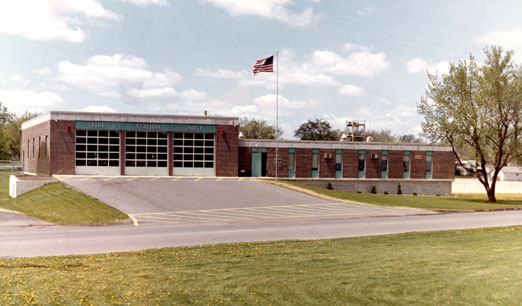
1966
The South Side Station – Station No. 1 at 3750 Wooddale – was completed in June 1966 and dedicated on October 7, 1966 to Joseph S. Williams, who helped organize the fire department in 1892 and served as chief for 52 years. The station was equipped to sleep one captain and four firemen. It replaced the old fire barn on 37th Street. Cost: $150,000. Firemen completed some of the construction in an effort to cut costs.
Behind the 1966 cornerstone of the new station was placed a metal box that was welded shut on all sides. Some signatures and “1963” were etched into the box. It was found when the cornerstone was removed before the station was demolished in 2011. The photo at right shows Chief Luke Stemmer holding the mysterious time capsule at the groundbreaking ceremony for the new fire station #1, held on May 2, 2011.
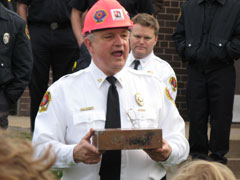
A spectacular garage file was put out at 4344 Vernon Avenue on January 15, 1966. The door had been left open and it was suspected that kids got into the gas in the snow blower and lawn mower. The fire was contained in the garage, but the entire house was smoke damaged.
1967
On December 7, 1966, a small fire at 4250 Vernon Avenue was called in by two adorable, smart, young neighbors. The heroines got their picture in the paper with Fireman Willard Murphy, who had just taught fire safety at Brookside School. They were awarded Gold Chief badges without winning the Essay Contest.
1968
On January 4, 1968, the Department took possession of a 1250 gallon per minute pumper, manufactured by Pirsch Co. of Kenosha, Wisconsin. It cost $27,000 and replaced the 1938 American LaFrance pumper.
On March 11, 1968, fireman Robert Bolmgren was commended by the City Council for rescuing Mrs. Robert Krause from a burning house.
1969
A new ordinance banned the burning of leaves.
The Roller Garden caught fire in 1969 when a tar heater owned by a roofing company burned through the roof. The fire department poured water from the outside, and the owners had fire extinguishers on the inside. Although some folks in the crowd shouted “Let that old barn burn down!” water was squeegied out the back door and the rink only opened a half hour late with a “Moonlight Skate.”
nbsp;
“Operation Fire Prevention” took place on October 8, 1969 – a surprise drill for the Mutual Aid Association of 17 fire departments in the southwest and lakes area. 350 firemen and 70 rigs showed up.
Chief Pete Williams resigned on December 12, 1969. He had been a volunteer firefighter since 1933 and on the paid staff since 1939. He died on June 17, 1970, six months after his retirement.
Omar McGary served as Chief from 1969 until he retired in 1979.
1970 City council minutes told of a plan to burn structures adjacent to Wolfe Park on 36th Street.
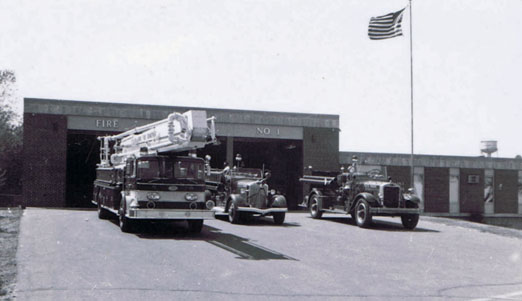
1971
The burning of the Pizza House at 4532 Excelsior Blvd. on October 8 was one of the most tragic in the history of the St. Louis Park Fire Department. Firefighters Arnold “Arnie” Johnson of 4124 Brookside, a professional, and Robert “Bob” McElmurry, a volunteer from Goodrich Avenue who was the son-in-law of Pete Williams, perished in the blaze. The fire started in packing boxes in the back hall about 1:30 a.m., discovered by the cook and a waitress. They evacuated the building, but they (or owner Tom Thielges) had to call the fire department from across the street, as the fire had already burned through the phone lines. Assistance in fighting the fire was provided by Hopkins and Edina. Don Glassing was in charge. Johnson and McElmurry entered the building when it appeared to be under control, but the fire was smoldering between the ceiling and the roof, and the ceiling collapsed on top of them. After an unsuccessful attempt to get the men out by Fire Captain Donald Glassing, who had been with them but went out to replenish his oxygen supply, the roof itself caved in.
Fire Chief Omar McGary speculated in an article in the Sun that:
“the restaurant’s huge ventilation system drew flame, heat, and smoke up through the ceiling. ‘When the wires on the ventilation system burned, the suction stopped and then everything broke loose. There was a quick flash and the fire was everywhere. The flames spread quickly. No one had time to do anything.'”
Approximately $25,000 was raised for the families of the fallen men. There was some internal criticism of the Department after the Pizza House fire. Volunteers were paid a nominal fee ($2 or $3) per fire, and to save money, a policy was instituted whereby each fireman would be given a number, and those with odd numbers would respond to calls on odd days and vice versa. It was charged that there were not enough men at the fire, and that equipment was set up but there was nobody to man it. This sentiment was repeated in 1975, when one Department historian said that although there was a sufficient amount of sophisticated equipment, the availability of sufficient numbers of fire fighters was in question. At that time there were 26 firemen stretched out over three shifts, covering two stations.
Three days later there was a fire at Gerlach Roofing at Gorham and Louisiana.
1972
The American Legion Hall burned down in June, started by ashes in a trash can. The gas station next door called in the alarm. The fire took two hours to subdue, and created $30,000 in damage, including several rare flags. The building was replaced by a new two-story building in 1973.
1973
The Red Owl store in Miracle Mile burned down on October 26, 1973. Follow the link for pictures of this tragic fire that eliminated the shopping center’s anchor.
In 1973 retired firefighters started meeting at Fire Station #1 (Louisiana) on the first or second Friday in May of each year. The men bought the groceries and the women cooked.
1974
In January 1973 an elderly woman lost her life when her home at 2732 Alabama Ave. burned.
In May 1973 a grass fire along the Great Northern tracks was caused by sparks from a faulty mechanism on a passing diesel train. Gusty winds spread the fire between the Jewish Community Center to Texas Ave. Four Park engine companies fought the rapidly-spreading flames while men and engines from Golden Valley and Edina manned the St. Louis Park fire stations.
In November 1973 a 55-gallon drum of duplicating fluid ignited at Benilde-St. Margaret’s, killing two boys and seriously injuring another.
The Department purchased two trucks: a 1250 gallons per minute GMP Pierce for $41,490 and a Ford 300 gallons per minute mini pumper for $13,000.
The City Council was split on whether fire engines should be red or yellow. Evidence of increased safety was cited, but Councilman Seymour Druskin pushed to keep fire trucks the traditional red.
1975
A fire ripped through the Shelard Plaza movie theater, causing $100,000 in damage. Fire departments from Golden Valley and Edina were called in to help fight the fire.
1976
In November 1976 the Westwood Hill Nature Center caught fire, and was battled by the St. Louis Park, Golden Valley, Hopkins, and Minnetonka Fire Departments.
1977
Belco (aka Burdick) Elevators 1 and 2 at 31st and Glenhurst burned down in a spectacular inferno on May 11. Follow the link above for pictures and details.
On November 30, 1977, fire raged through the home of Monroe Hartley Severson, 78, and his wife Charlotte S. Severson, 77 at 4371 Dart Ave. Both died in the fire, which was electrical in nature. Two young men from Minneapolis were driving nearby and saw the smoke. They got both occupants out of the house, but it was too late. The house, which was built in 1920, still stands today.
1978
The Lilac Lanes Bowling Alley caught fire on August 22, and it took the help of the Edina and Golden Valley fire departments to put it out.
The Volunteer Department, down to three men, was disbanded in 1978.
1979
The Foo Chu Cafe at 4215 Excelsior Blvd. burned down on New Year’s Eve. Owner Bob Fleming lived on the second floor and was almost killed. Temperatures of 10 below made the fire especially difficult to extinguish.
Back in the 1970s the Meadowbrook Medical Building (now part of Methodist Hospital) had a Smoking Aversion Room. This was a 4 by 7 ft. room which a company called Life Centers used to get people to quit smoking. It was furnished with only a chair, a tape deck, and a pile of burned out cigarettes on a desk. The subject is allowed to smoke in the room. On October 5, 1979, one of those cigarettes was not quite burned out and began to smoulder and flame up. It crossed the desk, lit a box of tissues, and started up the wall. Fire damage was estimated at $4,000. (SLP Sun, October 17, 1979)
Chief Omar McGary retired from the Fire Department on October 19, 1979 after 33 years, the last 10 as chief. At the time, the force had 24 men. John M. Kersey was named acting chief.
1981
Three suspicious garage fires caused more than $20,000 damage on March 31, 1981. The fires were in the Minnetonka Blvd. area between Edgewood and Idaho Avenues and all started at about 1:25 am. Destroyed were a 1977 Mustang and a 1975 Fiat. (SLP Sun, April 1, 1981)
1983
A February 16, 1983, fire at the McBee Building (4300 W. 36-1/2 Street at Excelsior Blvd.) caused damage estimated at $300,000. B&R Drapery and Home Furnishings and the International School of Bartending were destroyed. The fire may have been electrical, and carbon monoxide may have had something to do with it. The Edina Fire Department assisted and Golden Valley stood by to cover any other calls.
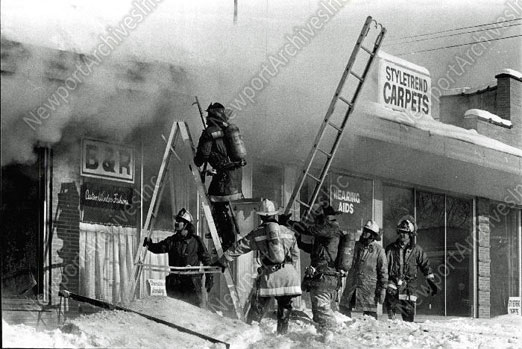
Fire broke out at Scherling-Pletsch Studio, 6610 W. Lake Street, on the morning of November 10, 1983. The studio had been in the Park since William Pletsch bought it in 1957. The company photographed school activities and events for yearbooks for 21 local high schools, and took about 7,000 graduation pictures a year. Only about 100 negatives were lost in the fire, but 1,500 sets of portraits for graduating seniors had to be redone. The fire started in the darkroom, blamed on faulty wiring. The site is now a McDonald’s parking lot.
1985
A suspicious fire happened at the offices of Marsh Productions, 6415 Walker Street, on January 4, 1985. Owner Jerry Shoberg said the back door had been kicked in and all the files had been gone through before the fire was set. He lost video tape decks, two TVs, two cassette players, desks, a copy machine, file cabinets, and – worst of all – phone numbers of contacts in the entertainment industry. Shoberg, who was confined to a wheelchair after breaking his neck 15 years before, had been in the entertainment booking business for 25 years. The shop next door, Norma’s Beauty Nook, was also damaged in the fire.
A blaze at a vacant warehouse required 109 personnel/54 firefighters to subdue on July 17, 1985. The warehouse was at 7400 Walker Street. It was owned by the Dominion Group Inc. of Minneapolis. and scheduled for demolition. Park police and fire had planned to conduct a training session at the site, but the fire was not a drill. Arson was suspected, as there was no electricity or gas hooked up and the fire spread exceedingly fast. Young people were seen leaving the site when the fire started.
In an ironic twist, an electrical fire caused more than $250,000 in damage to a butane torch factory. The fire happened on November 8, 1985 at Microflame, Inc. at 3724 Oregon Ave. Neighbors had to be evacuated but were returned quickly. General Manager Rick Kurzeka had been in business for 17 years. Fortunately, the fire did not reach the butane storage tanks, although a small tank in a torch kit exploded with a noise like a shotgun. The manufacturing machines and the company files were not damaged by the fire.
1986
Bernie’s Super Valu at the Westwood Hills Shopping Center (Louisiana Ave. and Cedar Lake Road) was destroyed by fire on Sunday, June 22, 1986. The fire started at about 7am, an hour before the store was scheduled to open. About 80 firefighters from seven communities battled the flames in high winds which made it difficult to contain. The fire wasn’t brought under control until about 2 pm, and the last firefighter was there until about 8 pm. Firefighters from St. Louis Park (whose fire station was across the street), Edina, Richfield, Eden Prairie, Golden Valley, and Minnetonka fought the blaze. Two firefighters received very minor injuries. The store employed 47 people and was managed by Bernard Purdy. Damage was estimated at $400,000 to contents and $500,000 to the building and fixtures, all insured. First reports indicated that the fire started in the meat department.
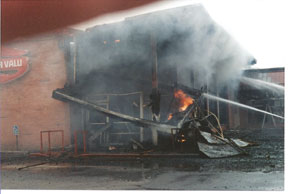
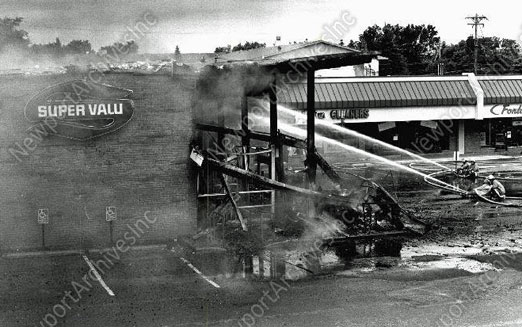
1989
A three-year-old with a cigarette lighter was the cause of a fire at Oak Park Village on October 3, 1989. The fire was contained within 30 minutes, but destroyed 22 units, causing $500,000 in damage.
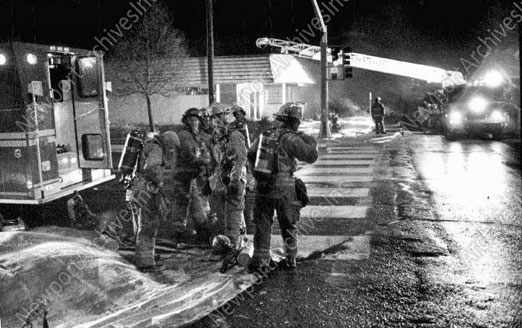
1993
A fire broke out at Ty’s New Park Market, 6312 Minnetonka Blvd. at 12:01 AM on Friday, November 5, 1993. The Hopkins, Edina, and Golden Valley Fire Departments assisted in fighting the blaze. The fire started in the basement in the rear of the store. The entire contents of the store was embargoed by the City Health Inspector and destroyed.
1998
The Department purchased Ladder One, a 75 foot Quint combination pumper/ladder. The unit has a 1500 gallons per minute pump and carries 500 gallons of water.It has an onboard generator and 121 feet of ground ladders. The photo below was a one of a series of cards issued by the Fire Department in 2003.
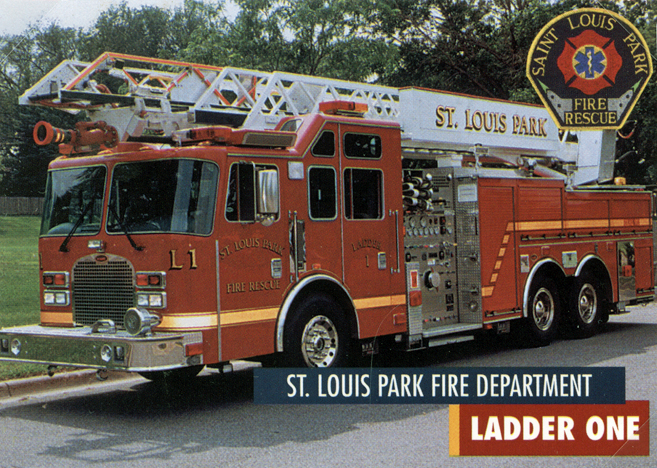
1999
The Dairy Queen at 4407 Excelsior Blvd. burned down. It was replaced in 2002.
A disgruntled resident set fire to curtains in his room at 3647 Sumter, a 15-room house converted to a facility for the mentally ill. Damage was confined to his room but the house was torn down and a new apartment building, Vail in the Park, was built in 2002.
2001
After a nationwide search, 25-year St. Louis Park Fire Department veteran Luke Stemmer was appointed Fire Chief at the City Council meeting on November 19, 2001. Stemmer grew up in Wayzata and began his careeer as a firefighter there at the age 21. Five years later he was hire by the St. Louis Park Fire Department, where he spent the rest of his career. He held a position in nearly every rank, including Deputy Chief. He served in leadership positions with the Chief’s Emergency Management Committee and the Statewide Mutual Aid Task Force.
2008
On Sunday morning, March 16, 2008, a raging house fire at 1405 Oregon Ave. So. caught the eye of Geoff Grassle as he drove along Interstate 394 toward downtown Minneapolis. He pulled off and followed the smoke, to find a raging house fire. Grassle found the door too hot to open, and firefighters who arrived minutes later found the homeowner dead in a back room, possibly trying to get a dog he was sitting for out of a kennel. The victim was Paul Hoenack, age 32. Another good Samaritan who came to help was Brian Dingman of Zimmerman, who woke Hoenack’s neighbors.
A second house fire in St. Louis Park that weekend injured Devon Straub and her two children. Chief Luke Stemmer said that the fire was caused by unattended food on a stove.
2009
Thomas Costello Holden, 56, died in a fire at his house on the 4100 block of Alabama Ave. He was found in the first-floor bedroom in mid-February.
The Minnesota State Fire Chief’s Association named Fire Chief Luke Stemmer its fire officer of the year in 2009.
2011
Plans were finalized for demolition and reconstruction of both fire stations. Groundbreaking for Station #1 was held on May 2, 2011. At the golden shovels below are City Council members Phil Finkelstein, Paul Omodt, and Anne Mavity, Mayor Jeff Jacobs, and Fire Chief Luke Stemmer. Sketches were released of the new Fire Station 1 and Fire Station 2. Fire Station 1 (Wooddale) was demolished on May 23, 2011.
A fire at the Natchez Place Condominiums on June 7, 2011 was not a big one, but was notable because that day the temperature rose to 103, causing hazardous conditions for firefighters. A normally one-alarm fire turned into five alarms as fire departments from numerous surrounding jurisdictions responded to the call in order to limit the time each firefighter was involved. Two MTC buses were on hand to provide a cool place for displaced residents and firefighters, and the Red Cross helped one displaced family find shelter. One firefighter from Golden Valley was taken to North Memorial Hospital, treated for a heat-related injury, and released. The fire was reportedly started by a careless smoker.
2012
The new Fire Station 2 (Louisiana) was placed in operation on March 12, 2012. The old station was demolished on April 23, 2012. The new station was dedicated on May 12, 2012. See a video of the dedication here, as provided by the St. Louis Park Patch.
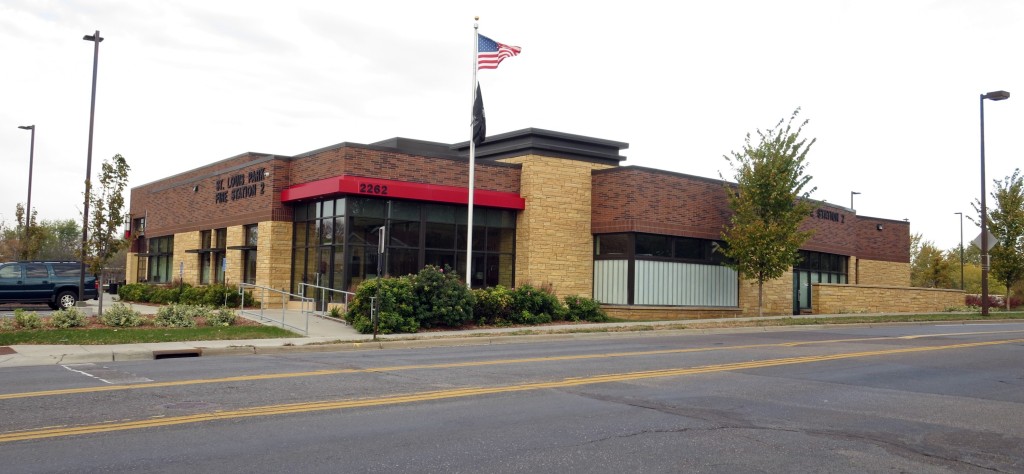
The new Fire Station No. 1 (Wooddale) was placed in service on May 14, 2012. It is 30,695 square feet in area and two stories tall. The building includes Fire Department administration offices, station administration, training room, kitchen/dayroom, fitness room, locker rooms, hose tower, sleeping quarters, and eight apparatus bays of varying depths. The building incorporates energy efficient and environmentally sound design in accordance with the St. Louis Park’s Green Building Policy.
The grand opening and memorial wall dedication took place on June 12, 2012. The memorial wall at Fire Station #1 was dedicated to the three St. Louis Park firefighters who lost their lives in the line of duty: Arnold “Arnie” Johnson of 4124 Brookside, a professional, and Robert “Bob” McElmurry, a volunteer from Goodrich Avenue, died in 1971’s Pizza House fire. Kurt “Cord” Scheibe, a Park firefighter since 1922, died of a heart attack at age 61 while fighting a small fire in the “bag room” at the National Lead Company in 1964.
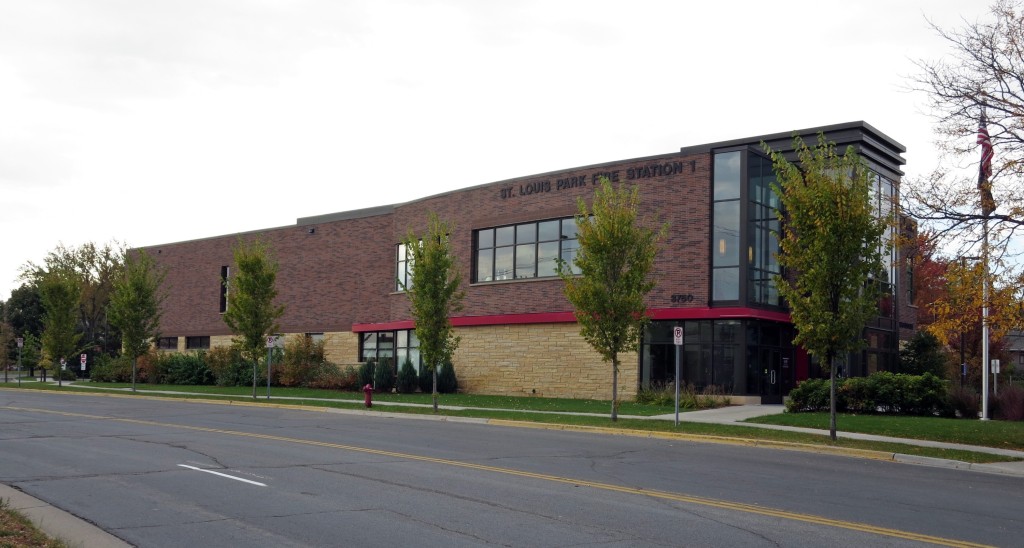
2013
Fire Station 1 was awarded Gold by Fire Chiefs Magazine.
Fire Chief Luke Stemmer retired on May 31, 2013.
2014
The house at 2917 Texa Tonka Ave. went up in flames on March 31, 2014. An initial blaze ignited oxygen tanks used by the occupant and caused loud blasts and considerable damage. Video was posted on YouTube by Anthony Merwin.
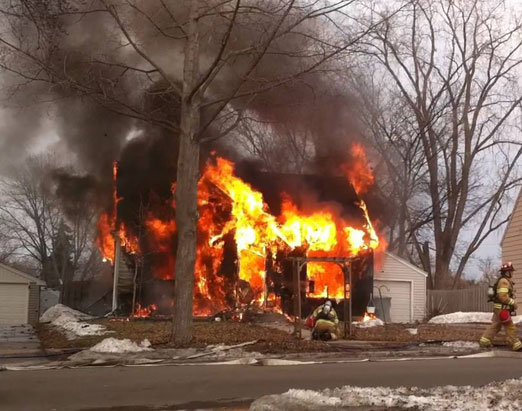
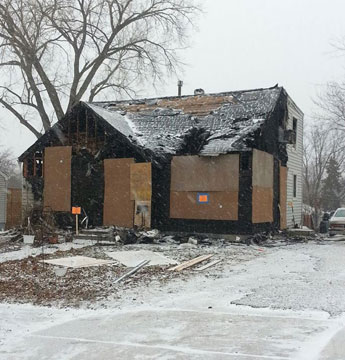
On October 23, 2014, four Park firefighters were presented with the Award of Merit from the Hennepin County Sheriff’s Office for their efforts to rescue five children trapped in a car submerged in a storm water pond at Highways 7 and 100. The incident happened on November 21, 2013. Firefighters Eric Bakken and Tim Smith swam toward the vehicle in the frigid water without any protective gear. Captain Paul Rosholt swam out and opened one car window and smashed another. Rosholt, Smith, and Lt. Dan Yaekel improvised a tether system to pull the children out of the water. Two of the children died in the accident, but the quick actions of the firefighters contributed to the saving of the lives of the other three.
2015
On September 15, 2015, the Fire Department celebrated its 100 year anniversary. The date was determined by items in the St. Louis Park Herald, published in 1915.
2016
The 2016 Fire Department Open House was on June 14, and despite the very rainy day there was an amazing turnout of about 1,000 people. Most things were moved indoors and the station was packed. The rain let up enough for the Department to do a kitchen fire demo and the burn rooms. An entire area was dedicated to the history of the Department.
ST. LOUIS PARK FIRE CHIEFS
1901: Charles (Butch) Miller – left after 6 months to find gold in Alaska.
1903-1946: Joe S. Williams started as a volunteer in 1891 and became Chief of that organization in 1903. When the Fire Department became a paying proposition in 1930, Joe was again Chief until he retired.
1946: An article in the Dispatch says that Lars Johnson was appointed temporary chief, holding this job close to a year until an examination could be held.
1946 to 1969: Charles M. (Pete) Williams
1969 to 1979: Omar McGary (Volunteer since 1946)
1979 to 1987: John M. Kersey – Assistant Chief 1972-79, acting Chief from 1979-80, Chief from 1980-87.
1989 to 1992: David Robertson, from Salina, Kansas, January 26, 1988 to March 20, 1992
1992 to 2001: Robert Gill, a 19-year veteran of the Fire Department, became Chief on July 27, 1992 (firefighter since 1973, assistant chief since 1991). He retired in 2001.
2001 to 2013: Luke L. Stemmer joined the Department on August 16, 1976, and became Chief on November 20, 2001. He retired on May 31, 2013.
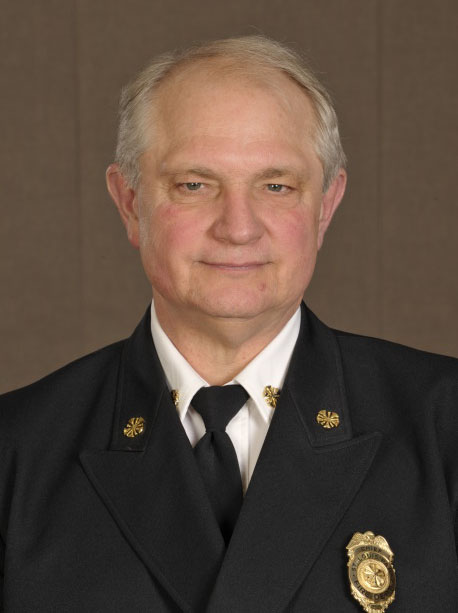
2013 to 2024: Steve Koering was assistant fire chief of operations at Eden Prairie and had worked at the EP fire department for 24 years. He became Chief on November 18, 2013. He retired on July 12, 2024.
Interim Chief Mike Scott had retired in May 2021 after 35 years of service to Eagan’s fire department.
2025: Chief Peter Hanlin was sworn in on February 24, 2025.
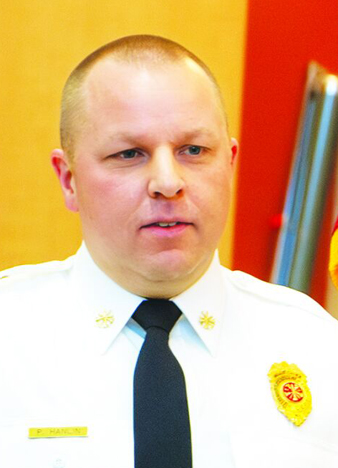
SERVICE RECORD OF VOLUNTEER FIRE DEPARTMENT
The Volunteer Fire Department was formally organized in 1915; before that fires were handled by a Bucket Brigade and the fire department of the Monitor Drill. The following dates were taken from a document found in the Society’s files, and attendance record from meeting minutes from 1938 to 1956. The mass exodus in 1955 was in part due to the establishment of a paid Fire Department that came about with the new City Charter. There was also an apparent enforcement of a mandatory retirement age of 60. Although we have no records after 1956, the Volunteer Fire Department lasted until 1978, when it was disbanded with only three members remaining.
|
NAME |
DATES OF SERVICE |
|
S. Earl Ainsworth |
September 1921 – November 1953 |
|
Vern Anderson |
September 1951 – February 1955 |
|
William Bernstein |
October 1954 – February 1955 |
|
Adolph H. Bettschart |
January 1937 – December 1945 |
|
Herman J. Bolmgren |
April 1925 – January 1955 |
|
Robert Bolmgren |
October 1954 – February 1955 |
|
Fred Borne |
February 1935 – March 1941 |
|
Robert Bramwell |
October 1955 – 1956 |
|
Louis L. Brown |
June 1901 – May 1941 (died August 27, 1942) |
|
Edward Broz |
June – December 1955 |
|
Leo Burns |
April 1953 – 1956 |
|
Art Buelow |
May 1953 – February 1955 |
|
Tom Campbell |
October 1944 – March 1948 |
|
Axel Carlstrom |
1915 (Honor Roll by 1938) (died November 1953) |
|
Bernie Chihoski |
April – June 1953 |
|
C. Ed Christy |
September 1922 – February 1954 (d. March 17, 1954) |
|
Robert Dean |
June 1955 – May 1956 |
|
Barney Dieringer |
November 1916 – February 1940 |
|
Al Donahue |
April 1953 – October 1955 |
|
William Dreyer |
March 1916 – January 1941 |
|
Bill Frank |
April 1953 – 1956 |
|
Irvin Freeland |
August 1932 – February 1955 |
|
Don Gallaway |
April 1953 – 1956 |
|
George Gibson |
December 1936 – February 1955 |
|
Donald Glassing |
November 1947 – February 1955 |
|
Charles H. Hamilton |
June 1901 – 1938 (died October 1938) |
|
Truman S. Hedwall |
January 1945 – February 1955 |
|
Frank Heyda |
(1915) March 1917 – February 1951 |
|
Gerald Hines |
December 1953 – February 1955 |
|
Harold Hofstrand |
February 1935 – 1956 |
|
Carl Iverson |
February 1945 – 1956 |
|
Clyde Johnson |
November 1947 – February 1955 |
|
Lars Johnson |
November 1918 – February 1955 |
|
Louis Johnson |
January 1945 – 1956 |
|
Roy R. Johnson |
1915 |
|
Maynard Kays |
April 1953 – 1956 |
|
Edward Kirk |
June – December 1955 |
|
Gilbert “Gib” Larson |
March 1916 – January 1942 |
|
Lewis B. Larson |
March 1916 – March 1942 |
|
Nels Larson |
January 1927 – October 1947 (died March 1956) |
|
Harry Lea |
November 1926 – February 1950 |
|
Robert London |
October 1955 – 1956 |
|
Albert Lundberg |
September 1922 – 1952 (died July 1953) |
|
Gene McGary |
May 1953 – February 1955 |
|
Lloyd McGary |
January 1945 – May 1949 |
|
Omar McGary |
October 1946 – February 1955 |
|
Melvin Markuson |
June 1955 – 1956 |
|
Charles “Butch” Miller |
June – December 1901 |
|
Walter Moore |
1915 |
|
William Moulton |
April 1935 – September 1938 |
|
Peter Mueller |
December 1953 – February 1955 |
|
M.G. Munson |
(Honor Roll by 1938) |
|
Willard Murphy |
May 1953 – February 1955 |
|
Andy Nelson |
April 1923 – March 1955 |
|
Oscar Nelson |
(Honor Roll by 1938) |
|
Robert Pastorek |
October 1955 – 1956 |
|
Howard W. Perkins |
December 1936 – April 1953 |
|
Charles Peterson |
November 1916 – August 1940 |
|
James Quinn |
October 1954 – February 1955 |
|
Ed Renner |
June 1921 – January 1955 |
|
Tom Renner |
October 1955 – 1956 |
|
W.A. “Al” Ruth |
June 1925 – August 1949 |
|
Clayte Scheibe |
June 1955 – 1956 |
|
Kurt Scheibe |
September 1922 – February 1955 |
|
Donald Senander |
October 1955 – 1956 |
|
Francis J. Senander |
February 1935 – November 1955 |
|
Richard “Dick” Senander |
April 1953 – 1956 |
|
Earl Sewall |
September 1927 – July 1946 |
|
Robert Sewall |
June 1955 – 1956 |
|
E. Smith |
(before 1938) – September 1941 |
|
James Smith |
(Honor Roll by 1938) |
|
Robert M. Sorenson |
April 1945 – 1956 |
|
Ed Stoops |
(Honor Roll by 1938) |
|
Vern Tollefsrud |
April 1953 – 1956 |
|
George Vita |
June 1955 – 1956 |
|
Dr. G.M. Wade |
1915 |
|
Ralph Wagner |
October 1930 – June 1953 |
|
Jock Warnes |
June 1955 – 1956 |
|
Jack Webster |
March 1934 – December 1941 |
|
Edward J. Werner |
December 1916 – January 1955 |
|
Frank Werner |
March 1917 – August 1944 (died July 1950) |
|
Jake Werner |
December 1916 – January 1955 |
|
Daniel Whalen |
October 1946 – August 1953 (d. Aug. 1953) |
|
Tom August Whalen |
1937 – 1940 (died 8/13/1940) |
|
Elmer Whipps |
1915 |
|
Charles “Pete” Williams |
March 1933 – February 1955 |
|
George Williams |
(before 1936) – July 1951 |
|
Howard J. Williams |
October 1918 – January 1955 |
|
Joseph S. Williams |
Bucket Brigade 1899; June 1901 – July 1946 |
|
Willard G. Williams |
January 1922 – February 1955 |

